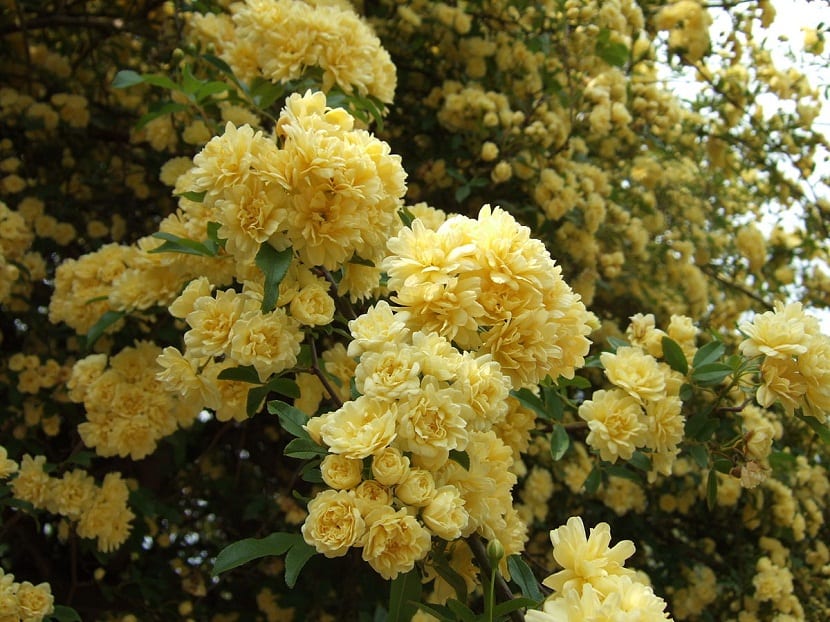
Not only palaces deserve to have the Rosa Banksia (Rosa banksiae Lutea), your also you should have her at home for her lush foliage and easy maintenance. The flower native to western China is named after the wife of Sir Joseph Banks.
William Keer was commissioned to feed the idyllic love story in 1807, after an expedition commissioned by Sir Banks to the eastern country. The large bouquet of small, pale yellow flowers received its name upon arrival in Europe.
Characteristics of Rosa banksia

This episode made the plant very used by landscapers and gardeners who used it thanks to its early flowering at the beginning of spring, for not having thorns and its faint aroma of violets.
Later years other forms of the species were discovered but all inspired by "Lady Banks' yellow rose".
The recent restoration of the gardens of Rosecliff Palace in Newport shows the relevance and majesty that Rosa banksia had for ornament a century later in the US.
To date, the largest and most prosperous rose bush in history is planted on the roof of a rural house in Tombstone, Arizona, resisting arid conditions. This is the living example of how practical your care can be.
Botanical professionals assure that since it is a plant that has grown in nature, it does not need much help, in fact, it is a semi-climbing shrub which usually has evergreen leaves, very unusual in the world of roses.
Care
Keeping these flowers yellow is not complicated, it is a sun loving plant that it needs a well drained and fertile soil for its growth that reaches up to six meters in height. If you live in a coastal area, this is the rose you need for your garden.
Your optimal soil must be loose for your roots to grow, just like support must be offered so that it can climb, being very common to see it on fences, pergolas and walls.
The Rosa Banksia is ideal for those who do not have much time, since its irrigation can be sporadic, as long as there is moisture in the soil and good organic matter. Gardeners recommend that twice a week be fine, although you have to make sure that the ground is completely dry.
It is usually in late winter when composting is done, but only in spring can chemicals be used to get abundant flowers and then be able to prune it. The caveat is that you should never prune before flowering, much less during the first two years.
How to detect pests?

Although it is a strong shrub, sometimes you can get powdery mildew. During the winter the cold and the humidity produce the conditions, but nothing that the summer sun does not cure.
Generally, white spots usually appear on newer leaves. They are also deformed and wrinkled before falling, however, the flower is the only thing that does not show symptoms.
Actually, a good preventive work must be done to avoid plant infections, since it is not very economical to eliminate the fungus. Specialists recommend a treatment with sulfur-based products and the care would imply controlling the temperature and the humidity, avoiding succulence in the fabrics, eliminating the contaminated areas, disinfecting the tools.
Pruning the Rosa banksiae Lutea
Banksia family roses should be cut after flowering, but beware, we should not cut the rose in the first two years of growth to get the right size.
When the rose begins to bloom, it can only be pruned after flowering. This shrub blooms on twigs from last year's rose bush, so it will not be pruned in spring, since we would not have roses during the year.
How beautiful.
I'm in Patagonia, Commodore Rivadavia.
We don't usually have temperatures below -3, but we do have a lot of wind.
Do you know how this plant resists the wind?
Hello Hugo.
Rose bushes in general are quite resistant to the wind, but it all depends on how often and at what intensity it blows.
It is not the same for a few single days a year that blows at about 40-50km / h, than several weeks or months with 60-70km / h or more.
If you want to have a banksia rose, I recommend protecting it a little from the wind, just in case. For example, with conifers or putting it in a corner.
If you have any questions, ask 🙂
Greetings.
Hi! I love this rose bush, a friend has just pruned hers, which is several years old, and she has given me several pods, but she tells me that they are not planted like other rose bushes… could you explain how to plant them? I still have them in a bucket with water ...
I have a lot of garden and I have already reserved a place for her with a couple where she will receive the morning sun and be sheltered from the winds… Thank you !!
Hi Mirta.
You can impregnate the base with cinnamon or some homemade rooting, and then plant them in a pot with soil.
Of course, the best time to do it is in late winter or early spring.
Greetings.